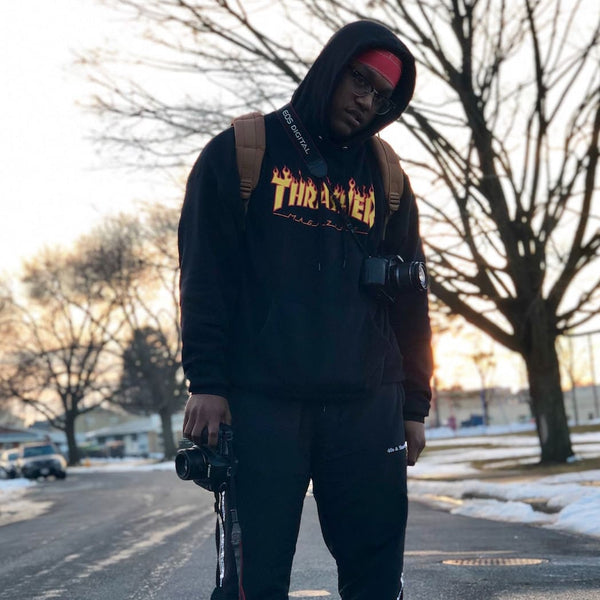
The Real History of The Hoodie
Share
The hoodie is more than just a piece of clothing, it's a cultural icon that has traversed diverse worlds, from the labor fields to Hollywood's red carpets. This seemingly simple garment, designed with a hood and often a large pocket at the front, has evolved to symbolize various facets of society, embodying statements of fashion, function, and even political protest. In this article, we'll delve into the fascinating history of the hoodie, exploring its origins, its cultural evolution, and its modern-day versatility that makes it a staple in closets around the world.
The Fascinating Journey of the Hoodie from its Humble Beginnings
The origin of the hoodie takes us on a trip back in time, far from its contemporary ubiquity in modern fashion. The concept of a garment with a hood isn't new; it dates back to Medieval Europe. Monks during this era wore hooded robes, referred to as "cowls," serving both functional and religious purposes. Fast-forwarding to the 1930s in the United States, the hoodie as we know it today was born, thanks to the clothing company Champion. They designed the first hooded sweatshirt aimed at laborers in freezing warehouses in upstate New York. The design solved a very practical problem, keeping workers warm and comfortable during harsh winter months.
Interestingly, the hoodie wasn’t initially intended for the fashion runway or the high street; it was workwear designed for functionality. It didn't take long, however, for the design to catch on. By the 1970s, the hoodie had crossed over into mainstream apparel. Athletes began to embrace this novel invention for its ease and comfort. Universities and colleges saw the hoodie as an ideal canvas for logos and school colors, marking the beginnings of its transition from a utilitarian garment to a fashion statement. This iconic piece of clothing thus set off on its journey from a purely functional item to a symbol layered with varied cultural meanings.
The Hoodie's Original Crowd: From Workers to Athletes
In its early days, the hoodie was a far cry from a fashion staple. It was initially designed with the American worker in mind. As mentioned, Champion produced the first iterations of the hooded sweatshirt specifically for laborers toiling away in frigid conditions, such as those in upstate New York’s freezing warehouses and meatpacking plants. The hoodie's primary purpose was utility; its design focused on warmth and comfort. Hoodies acted as an extra layer that could be easily added or removed depending on the temperature, thus making it extremely versatile.
As the hoodie began to gain wider recognition, athletes were quick to adopt it. Notably, boxers and athletes in training found the hoodie indispensable. It was the perfect garment for entering the ring or hitting the track, providing both the warmth needed to keep muscles loose and the ability to quickly "de-layer" as their bodies warmed up. Universities started incorporating hoodies into their athletic apparel, emblazoning them with their logos and colors. The cozy fit and functional design made hoodies an instant hit in the athletic world, acting as the stepping stone for its eventual cultural takeover.
The Hoodie's Metamorphosis Through Cultural Movements

The hoodie’s cultural evolution is as dynamic and multifaceted as the garment itself. One of the most significant turning points was its adoption by the hip-hop culture in the 1970s and '80s. The hoodie became synonymous with the raw, rebellious essence of urban life, embodying a sense of anonymity, audacity, and social critique. In hip-hop, the hoodie was more than just an item of clothing; it was a symbol of a countercultural movement that gave voice to marginalized communities. Artists and fans alike would don hoodies, often oversized, both as a fashion statement and a defiant expression against societal norms.
Skate culture fashion also embraced the hoodie with open arms. Skaters found the hoodie to be practical and stylish, fitting well with their high-energy, unrestricted lifestyle. The hood could be flipped up for a semblance of privacy, or to shield against wind while zipping down a slope. In this sense, the hoodie further solidified its association with subcultures that thrived on a spirit of rebellion and freedom. From the gritty streets of hip-hop culture to the freewheeling world of skaters, the hoodie has displayed a remarkable ability to adapt and evolve, embedding itself in various cultural movements across the board.
How the Hoodie Became a Pop Culture Icon

In the realm of pop culture, the hoodie has carved out a space for itself that's just as prominent as its historical and cultural roles. One can't discuss the hoodie's influence without mentioning its iconic appearance in the movie "Rocky." Sylvester Stallone, clad in a gray hoodie, jogging up the steps of the Philadelphia Museum of Art, became an unforgettable image that not only bolstered the hoodie’s popularity but also cemented its status as a symbol of grit, determination, and the American dream.
In the world of music, especially in genres like rap and hip-hop, the hoodie has been both a wardrobe staple and a political statement. Artists like Jay-Z, Eminem, and Kendrick Lamar have all sported hoodies in music videos and live performances, giving this humble garment a sense of swag and deeper cultural significance. But it's not just limited to one genre; rock stars, pop icons, and even country musicians have incorporated hoodies into their signature styles. Moreover, the hoodie has made its way into the art world, with famous graffiti artists often depicted in hoodies, emphasizing its impact as a universal cultural symbol.
The Hoodie in Today's Diverse Social and Professional Landscapes

In today's society, the hoodie has transcended its roots as workwear and athletic apparel to become a versatile piece in almost everyone's wardrobe. It's not uncommon to see hoodies worn in a wide range of social settings from casual meet-ups with friends to more formal business-casual environments. The hoodie has become an acceptable, even stylish, choice for many occasions, thanks in part to the high-quality materials and sleek designs now available. The days of the hoodie being labeled as "sloppy" or "unprofessional" are fading, as even corporate America has started to embrace this comfortable attire.
Equally noteworthy is the hoodie's role in social activism. It has become a symbol of social justice movements, prominently worn at protests and rallies. The "hoodie" was notably at the center of conversations surrounding the Trayvon Martin case, turning it into a powerful statement against racial profiling and social inequality. Whether it’s worn for comfort, style, or to make a statement, the hoodie has secured its place in modern society. It's no longer just a piece of clothing but a versatile tool for self-expression, a testament to its remarkable journey from humble beginnings to a modern-day essential.
Conclusion
The story of the hoodie is one of adaptation and transformation, a testament to how a functional garment can evolve into a powerful symbol laden with diverse meanings. From its humble beginnings in chilly warehouses to its prominence in fashion runways and political movements, the hoodie has proven its staying power. It’s not just about keeping warm or making a style statement; it’s about the narrative that unfolds each time someone dons this versatile garment. As you pull on your next hoodie, consider the rich tapestry of history and culture that you're wrapping yourself in.
